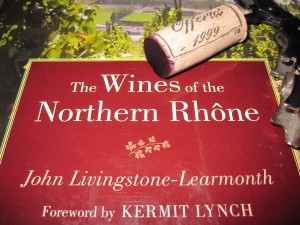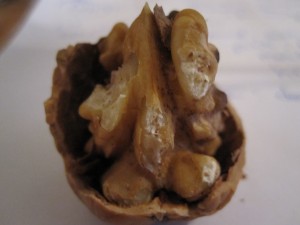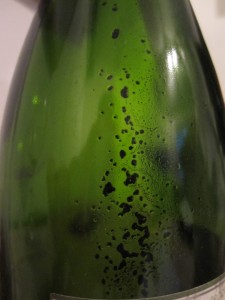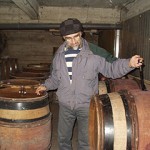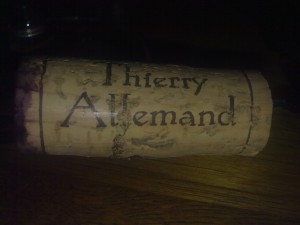
A local boy who didn’t have the fortune of being born into a wine making family, nor did he inherit any vineyards, Thierry’s interest was self-inflicted. He was a young, “angry teenager” when he created his first vineyard in 1982, a tiny 0,26HA (0,16HA of this were vines planted in 1961), next to Auguste Clape (La Côte), slowly thereafter adding two more tiny, well-located plots, Chaillot & Tézier. For the most part the vines were young, but to these babies he added some vineyards dated 1905-1908 and shortly thereafter, the addition of some Reynards that dated back to 1934. He now has a total of 4,15HA.
Today, Thierry produces three wines. Chaillot (approx 6000 bottles) from vines of less than 40 years of age, the older vine Reynard (approx 6000 bottles), and his sulfur-free version of Reynard (simply called “Cornas”, approx 2000 bottles), the wine discussed here.
Thierry has always worked on his own without an agricultural diploma, and without paying attention to what his neighbors were doing. He does his own rootstock grafting and pruning of the vineyards to get his yields down to about 25-30 HL/HA. He typically harvests later than his neighbors taking on more risk, yet allowing him to avoid chapatilization (the adding of sugar to unfermented grape must to increase alcohol).
In the cellar, he has practiced very low sulfur dosages in his vats since 1992. In 1996 & 1997, he used no sulfur. He has been making his Sans Soufre “Cornas” (from the Reynards vineyard) since 1998. He is known to use some other unorthodox techniques in Cornas like Macération Carbonique (carbonic maceration) for some of his grapes to extract fruit and to secure finesse. The Syrah grape is a grape that often requires aeration to eliminate the threat of reduction. Thierry’s answer this is simple: “I don’t add sulfur. Then you can leave the wine alone”, he goes on to say.
Date tasted: June 2, 2010 23:30
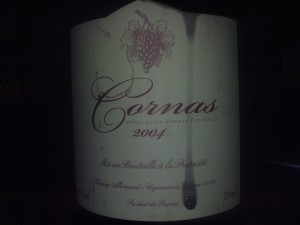 Appearance: Very deep red with little or no visible development. I must disclose, however, that the room was very dimly lit and it was very difficult to gage any visible development.
Appearance: Very deep red with little or no visible development. I must disclose, however, that the room was very dimly lit and it was very difficult to gage any visible development.
Nose: Young & tight, extremely balanced nose of dark fruit with a bright fruit background. Super young black olives with fresh pepper. Very focused indeed. A very expressive Syrah and a very typical Allemand.
Palate: Dark berries with sour red fruit to balance out the wine. Gripping acids and elegant tannins and a finish that “sticks around” for seemingly forever. A very sexy wine that can remind of a top Burgundy in its youth. Very elegant, tight and fresh. Very focused, tight, balanced and sexy! The alcohol is barely perceptible. A statement in elegance, finesse and freshness.
00:36
Still an amazing and open wine, but very, very slight oxidation was showing at this point.. Then the wine disappeared into our bellies
I have had the extreme fortune of tasting Allemand’s wines on numerous occasions and although my palate has evolved, his wines never cease to impress me. I’ll raise a glass in his honor any time.
(Thank you to John Livingstone-Learmonth and “The Wines of the Northern Rhône” for the useful Thierry Allemand information)
]]>
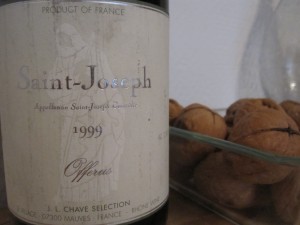 This wine is from the négociant business of Jean-Louis Chave, considered by many to be the top Hermitage producer. The Saint-Joseph is called “Offerus” and the Côtes du Rhône “Mon Coeur”. We are quite lucky in Norway to also receive small quantities of red Crozes-Hermitage thanks to the importer Christopher Moestue who’s an old friend and harvester. There can be up to 9 suppliers of grapes for the “Offerus”, with each of the wines vinified separately in each grower’s cellar. The wine is stored in 3-6 year old casks for 12-14 months. Only 50,000 bottles are made. Oh yeah, and of course this is 100% (mature) Syrah
This wine is from the négociant business of Jean-Louis Chave, considered by many to be the top Hermitage producer. The Saint-Joseph is called “Offerus” and the Côtes du Rhône “Mon Coeur”. We are quite lucky in Norway to also receive small quantities of red Crozes-Hermitage thanks to the importer Christopher Moestue who’s an old friend and harvester. There can be up to 9 suppliers of grapes for the “Offerus”, with each of the wines vinified separately in each grower’s cellar. The wine is stored in 3-6 year old casks for 12-14 months. Only 50,000 bottles are made. Oh yeah, and of course this is 100% (mature) Syrah  12.5% Alcohol
12.5% Alcohol
Date tasted: June 02, 2010 21:12
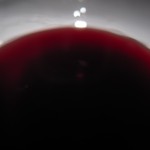 Appearance: Quite dark red still with surprisingly little development showing. The wine looks young for its age
Appearance: Quite dark red still with surprisingly little development showing. The wine looks young for its age 
Nose: Developed bouquet of pencil lead, black berries, raspberries, dark morel cherries with hints of bay leaf & black olives. No pepper aromas now.
Palate: Also showing development on the palate with black olives noted first with a very sour red fruit backbone. High acidity with medium tannins with a slightly oaky finish.
First impression suggests that the wine was lacking forward fruit and may have been past its prime. But read on!!
At 21:41 decanted the wine:
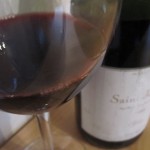 Nose: smoke & hints of white pepper emerging
Nose: smoke & hints of white pepper emerging
Palate: A bit more sweet fruit on the front now, but fading quickly giving way to under-ripe sour red fruit & spices. The finish is drying out a bit (not more necessarily tannic).
21:45 switched to a smaller format glass with smaller opening (more tulip shaped)
Nose: much tighter and focused now, yet less open. Cranberries.
Palate: tried the wine with some fresh walnuts and that really helped bring out the fruit!
22:02 – Yes, we still had some wine left! As the wine started to open, it became more difficult to not consume this bottle quickly!
The walnuts and the wine are a success – very enjoyable combo. They really helped bring out the sweet fruit in the wine (as did time).
Nose: More herbs
Palate: Still getting sweeter and the fruit is really opening up and beginning to shine! Alas, the wine is still alive and very very enjoyable!
The development nosed when the bottle was first opened, is not so apparent now as the fruit begins to shine. The wine actually seemed to be getting younger as time passed.
At this point, we really wished that this was a magnum cause it really began to drink well and we wanted more! If you have any bottles of the 1999, I would drink up because I don’t feel that the wine will benefit from any further cellaring.
What are we listening to as we consume this wine?? SYME! A band out of Bergen, Norway. Give them a listen to!
]]>
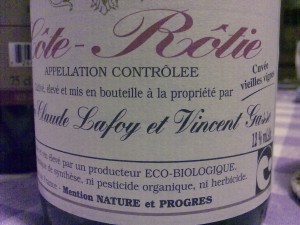 Date tasted: October 8th, 2009 at 23:00
Date tasted: October 8th, 2009 at 23:00
The Philosopher Grower Vincent Gasse lives just outside the main village of Ampuis, in the northern hamlet of Verenay, in the AOC Côte-Rôtie. From here he conducts his private campaign – to solve the conflict of making truly organic wine off slopes that crumble when you hand work their soil.
Vincent likes to stay out of the limelight. At 60 he is professorial, with a beard and what could be called wild hair, prominent bushy eyebrows, and glasses. In 2004 he decided to hang up his boots, and made just four casks of Côte-Rôtie from his plot on Le Goutay. His 1.3 hectares of vineyards, spread across five plots – Côte Rozier, Leyat, and Le Goutay on the full slopes and Bonnivière and Ritolas nearer the plateau – have been rented out to his fellow worker of the past seven years, Stéphane Otheguy. The oldest are Leyat and Bonnivière – both around 1945-1955 and planted by Marie Lafoy’s father, Pierre. The rest vary between 1985-1999.
Vincent makes his wine in the most constructive way possible since he feels strongly that the world’s resources are being rapidly depleted. He therefore carefully selects his vine stock, takes special care in the vineyards and when he makes the wine.
Vincent works organically (éco-biologique) and says that there are enormous extra costs in doing so. “The one big problem, he says, is how to work the soil – the rest of the issues can be solved”
“On slopes, manual weeding and working will take 1,000-plus hours, versus just 10 hours if you spray weedkiller,” he continues. “Say the weather is bad, you go up to 1,500 hours. And where are you going to find the people prepared to do this hard work? The challenge lies in the very word ‘Côte-Rôtie’ – which the next generation is going to have to find an answer to if they want to make true organic farming here economically sound.”
His first destalking was in the early 1990’s and vinification was in one open wood and one open concrete vat. No cultured yeasts have ever been used, and after a cool maceration, vinification would last over three weeks.
The two-year ageing was done in used 228-liter casks (of 2nd, 3rd or 4th passing). All the wine was bottled, without fining or filtration. The first bottling was in 1988, and there was Cuvée Sophia made from under 20-year Syrah off Côte Rozier and Ritolas, and a Vieilles Vignes (for this tasting note) from old vines that are purely massale selection (the practice of propagating new plant material from numerous selected mother vines in the vineyard), without any clonal presence.
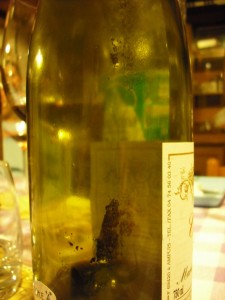 Soil: Schist and clay
0,4 ha organic vineyard
Guyot system
8800 vines per hectare
55 year average age of vines
39,5hl per hectare
100% hand harvest
Spontaneous fermentation
22 months on the fine lees in used barriques
No clarification or filtration
25 mg/liter total SO2
2100 bottles produced
Soil: Schist and clay
0,4 ha organic vineyard
Guyot system
8800 vines per hectare
55 year average age of vines
39,5hl per hectare
100% hand harvest
Spontaneous fermentation
22 months on the fine lees in used barriques
No clarification or filtration
25 mg/liter total SO2
2100 bottles produced
Tasting Notes:
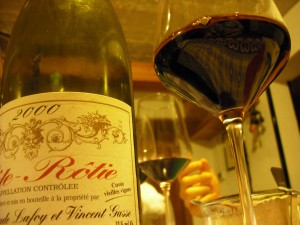 Appearance: Dark purplish-red with slight brownish edge. Medium plus intensity.
Appearance: Dark purplish-red with slight brownish edge. Medium plus intensity.
Nose: Medium intense, highly complex wine with aromas of cranberries, blackberries and wild raspberries. Spice, white pepper with a mineral backbone. Extremely complex bouquet with hints of black olives. Very intriguing and complex nose. Enticing.
Palate: Blackberries, wild cherries, cranberries, spice, dark olives with gripping medium level tannins with medium/high, mature acidity that carries the wine to a seemingly never-ending mineral finish. Very balanced and an impressive wine with only 12% alcohol. Very fresh and very drinkable. One of the freshest and lightest, yet concentrated Côte-Rôtie’s I’ve tasted. An impressive feat considering the very warm 2000 vintage which typically produced high alcohol, jammy wines.
(Thanks to John Livingstone-Learmonth’s “The Wines of the Northern Rhône” pages 93-95 for the Domaine and Vincent Gasse information used in this post)
]]>
